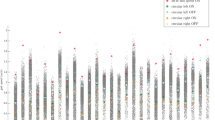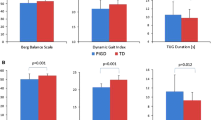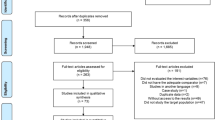Abstract
Instrumenting physical assessments in people with Parkinson’s disease can provide valuable and sensitive information. This study aimed to investigate whether variables derived from a Kinect-based system can provide incremental value over standard habitual gait speed (HGS) and timed up and go (TUG) variables by evaluating associations with (1) motor and (2) postural instability and gait difficulty (PIGD) subscales of the Unified Parkinson’s Disease Rating Scale (UPDRS). Sixty-two individuals with Parkinson’s disease (age 66 ± 7 years; 74% male) undertook an instrumented HGS and modified TUG tests, in addition to the UPDRS. Multivariable regression models were used to evaluate the associations of the Kinect measures with UPDRS motor and PIGD scores. First step length during the TUG and average step length and vertical pelvic displacement during the HGS were significantly associated with the PIGD subscale (P < 0.05). The only Kinect-derived variable showing additive benefits over the standard measures for the PIGD association was HGS vertical pelvic displacement. The only standard or Kinect-derived variable significantly associated with the motor subscale was first step length during the TUG (P < 0.01). This study provides preliminary evidence to support the use of a low-cost, non-invasive method of instrumenting gait and TUG tests in people with Parkinson’s disease.

ᅟ

Similar content being viewed by others
References
Bloem BR, Marinus J, Almeida Q, Dibble L, Nieuwboer A, Post B, Ruzicka E, Goetz C, Stebbins G, Martinez-Martin P, Schrag A, for the Movement Disorders Society Rating Scales Committee (2016) Measurement instruments to assess posture, gait, and balance in Parkinson’s disease: critique and recommendations. Mov Disord 31:1342–1355
Zampieri C, Salarian A, Carlson-Kuhta P, Aminian K, Nutt JG, Horak FB (2010) The instrumented timed up and go test: potential outcome measure for disease modifying therapies in Parkinson’s disease. J Neurol Neurosurg Psychiatry 81:171–176
Hoskovcová M, Dusek P, Sieger T, Brozová H, Zárubová K, Bezdicek O et al (2015) Predicting falls in Parkinson disease: what is the value of instrumented testing in off medication state? PLoS One 10:e0139849
Herman T, Weiss A, Brozgol M, Giladi N, Hausdorff JM (2014) Identifying axial and cognitive correlates in patients with Parkinson’s disease motor subtype using the instrumented timed up and go. Exp Brain Res 232:713–721
Clark RA, Bower KJ, Mentiplay BF, Paterson K, Pua YH (2013) Concurrent validity of the Microsoft Kinect for assessment of spatiotemporal gait variables. J Biomech 46:2722–2725
Galna B, Barry G, Jackson D, Mhiripiri D, Olivier P, Rochester L (2014) Accuracy of the Microsoft Kinect sensor for measuring movement in people with Parkinson's disease. Gait Posture 39:1062–1068
Eltoukhy M, Kuenze C, Oh J, Jacopetti M, Wooten S, Signorile J (2017) Microsoft Kinect can distinguish differences in over-ground gait between older persons with and without Parkinson’s disease. Med Eng Phys 44:1–7
Arango Paredes JD, Muñoz B, Agredo W, Ariza-Araújo Y, Orozco JL, Navarro A (2015) A reliability assessment software using Kinect to complement the clinical evaluation of Parkinson’s disease. Inst Electr Electron Eng Inc:6860–6863
Clark RA, Pua YH, Oliveira CC, Bower KJ, Thilarajah S, McGaw R, Hasanki K, Mentiplay BF (2015) Reliability and concurrent validity of the Microsoft Xbox One Kinect for assessment of standing balance and postural control. Gait Posture 42:210–213
Vernon S, Paterson K, Bower K, McGinley J, Miller K, Pua YH, Clark RA (2015) Quantifying individual components of the timed up and go using the Kinect in people living with stroke. Neurorehabil Neural Repair 29:48–53
Morris ME, Huxham F, McGinley J, Dodd K, Iansek R (2001) The biomechanics and motor control of gait in Parkinson disease. Clin Biomech 16:459–470
Stebbins GT, Goetz CG, Burn DJ, Jankovic J, Khoo TK, Tilley BC (2013) How to identify tremor dominant and postural instability/gait difficulty groups with the Movement Disorder Society Unified Parkinson’s Disease Rating Scale: comparison with the Unified Parkinson’s Disease Rating Scale. Mov Disord 28:668–670
Goetz CG, Tilley BC, Shaftman SR, Stebbins GT, Fahn S, Martinez-Martin P, Poewe W, Sampaio C, Stern MB, Dodel R, Dubois B, Holloway R, Jankovic J, Kulisevsky J, Lang AE, Lees A, Leurgans S, LeWitt PA, Nyenhuis D, Olanow CW, Rascol O, Schrag A, Teresi JA, van Hilten JJ, LaPelle N, for the Movement Disorder Society UPDRS Revision Task Force (2008) Movement Disorder Society-sponsored revision of the unified Parkinson’s Disease Rating Scale (MDS-UPDRS): scale presentation and clinimetric testing results. Mov Disord 23:2129–2170
Harrell FE Jr (2015) Regression modeling strategies: with applications to linear models, logistic and ordinal regression, and survival analysis. Springer, New York
Mentiplay BF, Perraton LG, Bower KJ, Pua YH, McGaw R, Heywood S, Clark RA (2015) Gait assessment using the Microsoft Xbox One Kinect: concurrent validity and inter-day reliability of spatiotemporal and kinematic variables. J Biomech 48:2166–2170
Podsiadlo D, Richardson S (1991) The timed ‘Up and Go’: a test of basic functional mobility for frail elderly persons. J Am Geriatr Soc 39:142–148
Ramaker C, Marinus J, Stiggelbout AM, van Hilten BJ (2002) Systematic evaluation of rating scales for impairment and disability in Parkinson's disease. Mov Disord 17:867–876
Durrleman S, Simon R (1989) Flexible regression models with cubic splines. Stat Med 8:551–561
Harrell Jr FE (2016) rms: Regression modeling strategies. R package version 5.0–1. http://CRAN.R-project.org/package=rms
Wickham H (2009) ggplot2: elegant graphics for data analysis. Springer, New York
Orendurff MS, Segal AD, Klute GK, Berge JS, Rohr ES, Kadel NJ (2004) The effect of walking speed on center of mass displacement. J Rehabil Res Dev 41:829–834
Clark RA, Williams G, Fini N, Moore L, Bryant AL (2012) Coordination of dynamic balance during gait training in people with acquired brain injury. Arch Phys Med Rehabil 93:636–640
Dewey DC, Miocinovic S, Bernstein I, Khemani P, Querry R, Chitnis S et al (2014) Automated gait and balance parameters diagnose and correlate with severity in Parkinson disease. J Neurol Sci 345:131–138
Acknowledgements
The authors would like to thank the Department of Nursing and Department of Physiotherapy at Singapore General Hospital for their support and assistance with data collection.
Funding
Author RAC is funded by a National Health and Medical Research Council Career Development Fellowship (#1090415). Author EKT is funded by a National Medical Research Council, Singapore Translational Research (STaR) Investigator award.
Author information
Authors and Affiliations
Corresponding author
Ethics declarations
Conflict of interest
The authors declare they have no conflict of interest.
Rights and permissions
About this article
Cite this article
Tan, D., Pua, YH., Balakrishnan, S. et al. Automated analysis of gait and modified timed up and go using the Microsoft Kinect in people with Parkinson’s disease: associations with physical outcome measures. Med Biol Eng Comput 57, 369–377 (2019). https://doi.org/10.1007/s11517-018-1868-2
Received:
Accepted:
Published:
Issue Date:
DOI: https://doi.org/10.1007/s11517-018-1868-2




